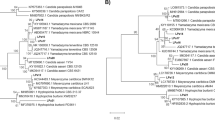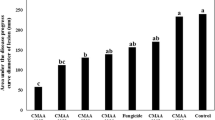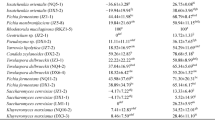Abstract
Anthracnose and stem-end rot are among the most devastating pathogens affecting mangos, leading to significant losses due to rotting during storage. This study aimed to investigate marine strains' potential as biocontrol agents against the postharvest pathogenic fungi Colletotrichum gloeosporioides and Lasiodiplodia theobromae. A total of 415 marine yeast strains isolated from marine environments were evaluated for their antifungal activities against C. gloeosporioides and L. theobromae using a dual culture method. Out of these, 115 yeast strains were found to inhibit the growth of C. gloeosporioides, while 31 strains inhibited the growth of L. theobromae. Among these yeast strains, only eighteen proved effective against both pathogenic fungi. The strains Meyerozyma guilliermondii ARU3232-1 and Pichia kudriavzevii DMKUJC44-2 demonstrated the most significant inhibition of radial mycelial growth. The production of volatile organic compounds (VOCs) showcased an in vitro inhibitory effect on the growth of both C. gloeosporioides and L. theobromae. However, assays testing the production of cellulase, chitinase, pectinase and protease by these antagonistic yeasts yielded negative results. Additionally, there was no observed Fe3+ binding competition between the yeast and mold. M. guilliermondii ARU3232-1 showed strong biofilm formation, while P. kudriavzevii DMKUJC44-2 demonstrated moderate biofilm formation. In vivo assays indicated that M. guilliermondii ARU3232-1 reduced anthracnose disease severity by 71 ± 3%, whereas P. kudriavzevii DMKUJC44-2 decreased stem-end rot severity by 61 ± 3%. Therefore, both antagonist marine yeasts have the potential to be used as biocontrol agents against anthracnose and stem-end rot diseases of mango fruits.




Similar content being viewed by others
References
Ajitomi, A., Minoshima, A., Takushi, T., Truong, H. H., Ooshiro, A., Yamashiro, M., Arasaki, C., & Hirooka, Y. (2020). First report of mango (Mangifera indica) stem-end rot caused by two Diaporthe species and their susceptibility to procymidone. Journal of General Plant Pathology, 86, 237–244.
Alkan, N., & Kumar, P. (2018). Postharvest storage management of mango fruit. Achieving sustainable cultivation of mangoes. Galan Sauco, Eds, 377–402.
Alvarez, A. M., & Nishijima, W. T. (1987). Post harvest diseases of papaya. Plant Disease, 71, 681–686.
Barkai-Golan, R. (2001). Postharvest disease of fruits and vegetables – Development and control. Elsevier Ltd.
Bautista-Rosales, P. U., Calderon-Santoyo, M., Servín-Villegas, R., Ochoa-Álvarez, N. A., Vázquez-Juárez, R., & Ragazzo-Sánchez, J. A. (2014). Biocontrol action mechanisms of Cryptococcus laurentii on Colletotrichum gloeosporioides of mango. Crop Protection, 65, 194–201.
Cheng, L., Zhou, L., Li, D., Gao, Z., Teng, J., Nie, X., Guo, F., Wang, C., Wang, X., Li, S., & Li, X. (2023). Combining the biocontrol agent Meyerozyma guilliermondii with UV-C treatment to manage postharvest gray mold on kiwifruit. Biological Control, 180, 105198. https://doi.org/10.1016/j.biocontrol.2023.105198
Chi, M., Li, G., Liu, Y., Liu, G., Li, M., Zhang, X., Sun, Z., Sui, Y., & Liu, J. (2015). Increase in antioxidant enzyme activity, stress tolerance and biocontrol efficacy of Pichia kudriavzevii with the transition from a yeast-like to biofilm morphology. Biological control, 90, 113–119.
Chi, Z., Liu, G.-L., Lu, Y., Jiang, H., & Chi, Z.-M. (2016). Bio-products produced by marine yeasts and their potential applications. Bioresource Technology, 202, 244–252.
Connell, L., Redman, R., Craig, S., Scorzetti, G., Iszard, M., & Rodriguez, R. (2008). Diversity of soil yeast isolated from South Victoria Land, Antarctica. Microbiology Ecology, 56, 448–459.
Delali, K.I., Chen, O., Wang, W., Yi, L., Deng, L., & Zeng, K. (2021). Evaluation of yeast isolates from kimchi with antagonistic activity against green mold in citrus and elucidating the action mechanisms of three yeast: P. kudriavzevii, K. marxianus, and Y. lipolytica. Postharvest Biology and Technology, 176, 111495. https://doi.org/10.1016/j.postharvbio.2021.111495
Galsurker, O., Diskin, S., Duanis-Assaf, D., Doron-Faigenboim, A., Maurer, D., Feygenberg, O., & Alkan, N. (2018). Harvesting mango fruit with a short stem-end altered endophytic microbiome and reduce stem-end rot. Microorganisms, 8, 558. https://doi.org/10.3390/microorganisms8040558
Gamagae, S. U., Sivakumar, D., & Wijesundera, R. L. C. (2004). Evaluation of post-harvest application of sodium bicarbonate-incorporated wax formulation and Candida oleophila for the control of anthracnose of papaya. Crop Protection, 23, 575–579.
Gardini, F., Tofalo, R., Belletti, N., Iucci, L., Suzzi, G., Torriani, S., Guerzoni, M. E., & Lanciotti, R. (2006). Characterization of yeasts involved in the ripening of Pecorino Crotonese cheese. Food Microbiology, 23, 641–648.
Gava, C. A. T., De Castro, A. P. C., Pereira, C. A., & Fernandes-Júnior, P. I. (2018). Isolation of fruit colonizer yeasts and screening against mango decay caused by multiple pathogens. Biological Control, 117, 137–146.
Guo, J., Zhang, X., Zhang, M., Zhou, S., Luo, X., Liu, J., Liu, J., Gao, J., & Zhao, X. (2023). Multiple pathways involving in the Ca ascorbate-induced enhancement of Meyerozyma guilliermondii biocontrol efficacy. Biological Control, 186, 105319. https://doi.org/10.1016/j.biocontrol.2023.105319
Huang, Y., Sun, C., Guan, X., Lian, S., Li, B., & Wang, C. (2021). Biocontrol efficiency of Meyerozyma guilliermondii Y-1 against apple postharvest decay caused by Botryosphaeria dothidea and the possible mechanisms of action. International Journal of Food Microbiology, 338, 108957. https://doi.org/10.1016/j.ijfoodmicro.2020.108957
Herrera-Balandrano, D. D., Wang, S.-Y., Wang, C.-X., Shi, X.-C., Liu, F.-Q., & Laborda, P. (2023). Antagonistic mechanisms of yeasts Meyerozyma guilliermondii and M. caribbica for the control of plant pathogens: A review. Biological control, 186, 105333 10.1016/j.biocontrol.2023.105333.
Johnson, G. I., Mead, A. J., Cooke, A. W., & Dean, J. R. (1992). Mango stem and rot pathogens fruit infection by endophytic colonization of the inflorescence and pedicel. The Annals of Applied Biology, 120, 225–234.
Kaewkrajay, C., Chanmethakul, T., & Limtong, S. (2020). Assessment of diversity of culturable marine yeasts associated with corals and zoanthids in the Gulf of Thailand. South China Sea. Microorganisms, 8, 474. https://doi.org/10.3390/microorganisms8040474
Kaewkrajay, C., Putchakarn, S., & Limtong, S. (2021). Cultivable yeasts associated with marine sponges in the Gulf of Thailand, South China Sea. Antonie van Leeuwenhoek, 114, 253–274.
Kasana, R. C., Salwan, R., Dhar, H., Dutt, S., & Gulati, A. (2008). A rapid and easy method for the detection of microbial cellulases on agar plates using Gram’s iodine. Current Microbiology, 57(503), 507. https://doi.org/10.1007/s00284-008-9276-8
Kurtzman, C. P., Fell, J. W., & Boekhout, T. (2011). Deffinition, Classification and Nomenclature of the yeast. In C. P. Kurtzman, J. W. Fell, & T. Boekhout (Eds.), The yeast a taxonomic study (5th ed.). Elsevier.
Li, Z. (2019). Sponge and coral microbiomes. In Symbiotic Microbiomes of Coral Reefs Sponges and Corals; Li, Z., Ed.; Spinger Nature: Berlin/Heidelberg, Germany, pp. 17–28.
Liu, J., Sui, Y., Wisniewski, M., Droby, S., & Liu, Y. (2013). Review; Utilization of antagonistic yeasts to manage postharvest fungal diseases of fruit. International Journal of Food Microbiology, 167, 153–160.
Liu, X., Gao, Y., Yang, H., Li, L., Jiang, Y., Li, Y., & Zheng, J. (2020). Pichia kudriavzevii retards fungal decay by influencing the fungal community succession during cherry tomato fruit storage. Food Microbiology, 88, 103404. https://doi.org/10.1016/j.fm.2019.103404
Medina-Córdova, N., López-Aguilar, R., Ascencio, F., Castellanos, T., Campa- Córdova, A. I., & Angulo, C. (2016). Biocontrol activity of the marine yeast Debaryomyces hansenii against phytopathogenic fungi and its ability to inhibit mycotoxins production in maize grain (Zea mays L.). Biological Control, 97, 70–79.
Merín, M. G., Mendoza, L. M., Farias, M. E., & Morata de Ambrosini, V. I. (2011). Isolation and selection of yeasts from wine grape ecosystem secreting cold-active pectinolytic activity. International Journal of Food Microbiology, 147(144), 148. https://doi.org/10.1016/j.ijfoodmicro.2011.04.004
Naim, M. A., Smidt, H., & Sipkema, D. (2017). Fungi found in Mediterranean and North Sea sponges: How specific are they? PeerJ, 5, e3722. https://doi.org/10.7717/peerj.3722
Nelson, S. C. (2008). Mango anthracnose (Collectotrichum gloeosporioides). In Cooperative Extension Service. University of Hawaii at Manoa.
Nujthet, Y., Kaewkrajay, C., Kijjoa, A., & Dethoup, T. (2023). Biocontrol efficacy of antagonists Trichoderma and Bacillus against post-harvest diseases in mangos. European Journal of Plant Pathology. https://doi.org/10.1007/s10658-023-02757-1
Nunes, C. A. (2012). Biological control of postharvest of fruit. European Journal of Plant Pathology, 133, 181–196.
Parafati, L., Vitale, A., Rextuccia, C., & Cirvilleri, G. (2015). Biocontrol ability and action mechanism of food-isolated yeast strains against Botrytis cinerea causing post-harvest bunch rot of table grape. Food Microbiology, 47, 85–92.
Paulino, G. V. B., Félix, C. R., Broetto, L., & Landell, M. F. (2017). Diversity of culturable yeasts associated with zoanthids from Brazilian reef and its relation with anthropogenic disturbance. Marine Pollution Bulletin, 123, 253–260.
Prusky, D. (1996). Pathogen quiescence in postharvest diseases. Annual Review of Phytopathology, 34, 413–434.
Prusky, D., & Plumbley, R.A. (1992). Quiescent infection of Colletotrichum in tropical and subtropical fruits. In: Baily, J.A., Jeger, M. (Eds.), Collectotrichum.
Robs, C. F. (1996). Enfermidades de pós-colheita do mamăo. In L. G. Mendes, J. L. L. Dantas, & C. F. G. Morales (Eds.), Mamăo No Brasil. EUFBA/ EMBRAPA-CNPMF, Cruz das Almas.
Růžička, F., Hola, V., Votava, M., & Tejkalova, R. (2007). Importance of biofilm in Candida parapsilosis and evaluation of its susceptibility to antifungal agents by colorimetric method. Folia Microbiologica, 52(3), 209–214.
Sarkar, A., & Rao, K. V. B. (2016). Marine yeast: A potential candidate for biotechnological applications-A review. Asian Journal of Microbiology, Biotechnology & Environmental Sciences, 18(3), 627–634.
Shen, H., Wei, Y., Wang, X., Xu, C., & Shao, X. (2019). The marine yeast Sporidiobolus pararoseus ZMY-1 has antagonistic properties against Botrytis cinerea in vitro and in strawberry fruit. Postharvest Biology and Technology, 150, 1–8.
Sholberg, P. L., & Conway, W. S. (2001). Postharvest pathology. http://www.ba.ars.usda.gov/hb66/022pathology.pdf. Accessed 28 Jul 2023.
Snowdon, A. I. (2010). A colour atlas of post-harvest diseases and disorders of fruit and vegetables: General Introduction and Fruits. Manson.
Souza, C. P., Burbano-Rosero, E. M., Almeida, B. C., Martins, G. G., Albertini, L. S., & Rivera, I. N. G. (2009). Culture medium for isolating chitinolytic bacteria from seawater and plankton. World Journal of Microbiology and Biotechnology, 25, 2079–2082.
Stepanović, S., Vuković, D., Hola, V., Bonaventura, G., Djukić, S., Ćirković, L., & Ruzicka, F. (2007). Quantification of biofilm in microtiter plates: Overview of testing conditions and practical recommendations for assessment of biofilm production by staphylococci. Acta Pathologica, Microbiologica, et Immunologica Scandinavica, 115, 891–899.
Suasa-ard, S., Eakjamnong, W., & Dethoup, T. (2019). A novel biological control agent against postharvest mango disease caused by Lasiodioplodia theobromae. European Journal of Plant Pathology, 155(2), 583–592.
Sun, C., Huang, Y., Lian, S., Saleem, M., Li, B., & Wang, C. (2021). Improving the biocontrol efficacy of Meyerozyma guilliermondii Y-1 with melatonin against postharvest gray mole in apple fruit. Postharvest Biology and Technology, 171, 111351. https://doi.org/10.1016/j.postharvbio.2020.111351
Vaca, I., Faúndez, C., Maza, F., Paillavil, B., Hernández, V., Acosta, F., Levicán, G., Martínez, C., & Chávez, R. (2013). Cultivable psychrotolerant yeasts associated with Antarctic marine sponges. World Journal of Microbiology and Biotechnology, 29, 183–189.
Wang, Y. F., Bao, Y. H., Shen, D. H., Feng, W., Yu, T., Zhang, J., & Zheng, X. D. (2008). Biocontrol of Alternaria alternata on cherry tomato fruit by use of marine yeast Rhodosporidium paludigenum Fell & Tallman. International journal of Food Microbiology, 123, 234–239.
Wang, Y., Yu, T., Xia, J., Yu, D., Wang, J., & Zheng, X. (2010). Biocontrol of postharvest gray mold of cherry tomatoes with the marine yeast Rhodosporidium paludigenum. Biological control, 53, 178–182.
Wang, Y., Tang, F., Xia, J., Yu, T., Wang, J., Azhati, R., & Zheng, X. D. (2011). A combination of marine yeast and food additive enhances preventive effects on postharvest decay of jujubes (Zizyphus jujube). Food Chemistry, 125, 835–840.
Zaky, A. S., Tucker, G. A., Daw, Z. Y., & Du, C. (2014). Marine yeast isolation and industrial application. FEMS Yeast Research, 14, 813–825.
Zhang, X., Hua, M., Song, C., & Chi, Z. (2012). Occurrence and diversity of marine yeasts in Antarctica environments. Journal of Ocean University of China, 11, 70–74.
Acknowledgements
This work was completely supported by a grant from the National Research Council of Thailand (NRCT) and would like to thank Prof. Dr. Savitree Limtong, Department of Microbiology, Faculty of Science, Kasetsart University, for a kindly and useful suggestion.
Author information
Authors and Affiliations
Corresponding author
Ethics declarations
Conflict of interest
The authors declare no conflict of interest.
Ethical approval
This article does not contain any studies with human participants or animals performed by any of the authors.
Rights and permissions
Springer Nature or its licensor (e.g. a society or other partner) holds exclusive rights to this article under a publishing agreement with the author(s) or other rightsholder(s); author self-archiving of the accepted manuscript version of this article is solely governed by the terms of such publishing agreement and applicable law.
About this article
Cite this article
Kaewkrajay, C., Dethoup, T. Biocontrol ability of marine yeasts against postharvest diseases in mangos caused by Colletotrichum gloeosporioides and Lasiodiplodia theobromae. Eur J Plant Pathol 168, 709–721 (2024). https://doi.org/10.1007/s10658-023-02795-9
Accepted:
Published:
Issue Date:
DOI: https://doi.org/10.1007/s10658-023-02795-9




